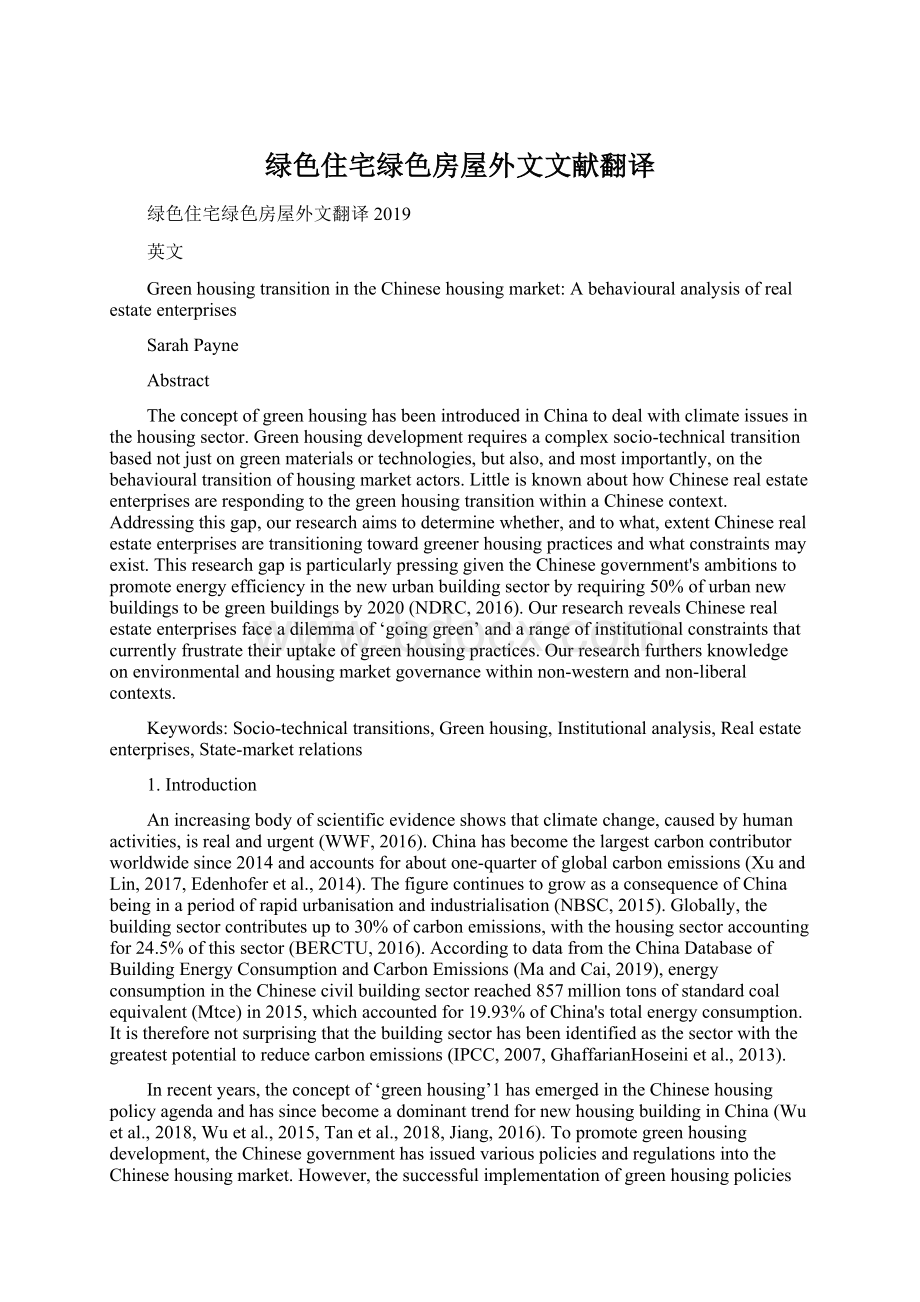绿色住宅绿色房屋外文文献翻译Word文档格式.docx
《绿色住宅绿色房屋外文文献翻译Word文档格式.docx》由会员分享,可在线阅读,更多相关《绿色住宅绿色房屋外文文献翻译Word文档格式.docx(9页珍藏版)》请在冰豆网上搜索。

TheconceptofgreenhousinghasbeenintroducedinChinatodealwithclimateissuesinthehousingsector.Greenhousingdevelopmentrequiresacomplexsocio-technicaltransitionbasednotjustongreenmaterialsortechnologies,butalso,andmostimportantly,onthebehaviouraltransitionofhousingmarketactors.LittleisknownabouthowChineserealestateenterprisesarerespondingtothegreenhousingtransitionwithinaChinesecontext.Addressingthisgap,ourresearchaimstodeterminewhether,andtowhat,extentChineserealestateenterprisesaretransitioningtowardgreenerhousingpracticesandwhatconstraintsmayexist.ThisresearchgapisparticularlypressinggiventheChinesegovernment'
sambitionstopromoteenergyefficiencyinthenewurbanbuildingsectorbyrequiring50%ofurbannewbuildingstobegreenbuildingsby2020(NDRC,2016).OurresearchrevealsChineserealestateenterprisesfaceadilemmaof‘goinggreen’andarangeofinstitutionalconstraintsthatcurrentlyfrustratetheiruptakeofgreenhousingpractices.Ourresearchfurthersknowledgeonenvironmentalandhousingmarketgovernancewithinnon-westernandnon-liberalcontexts.
Keywords:
Socio-technicaltransitions,Greenhousing,Institutionalanalysis,Realestateenterprises,State-marketrelations
1.
Introduction
Anincreasingbodyofscientificevidenceshowsthatclimatechange,causedbyhumanactivities,isrealandurgent(WWF,2016).Chinahasbecomethelargestcarboncontributorworldwidesince2014andaccountsforaboutone-quarterofglobalcarbonemissions(XuandLin,2017,
Edenhoferet
al.,2014).ThefigurecontinuestogrowasaconsequenceofChinabeinginaperiodofrapidurbanisationandindustrialisation(NBSC,2015).Globally,thebuildingsectorcontributesupto30%ofcarbonemissions,withthehousingsectoraccountingfor24.5%ofthissector(BERCTU,2016).AccordingtodatafromtheChinaDatabaseofBuildingEnergyConsumptionandCarbonEmissions(MaandCai,2019),energyconsumptionintheChinesecivilbuildingsectorreached857 milliontonsofstandardcoalequivalent(Mtce)in2015,whichaccountedfor19.93%ofChina'
stotalenergyconsumption.Itisthereforenotsurprisingthatthebuildingsectorhasbeenidentifiedasthesectorwiththegreatestpotentialtoreducecarbonemissions(IPCC,2007,
GhaffarianHoseiniet
al.,2013).
Inrecentyears,theconceptof‘greenhousing’1
hasemergedintheChinesehousingpolicyagendaandhassincebecomeadominanttrendfornewhousingbuildinginChina(Wuet
al.,2018,
Wuet
al.,2015,
Tanet
Jiang,2016).Topromotegreenhousingdevelopment,theChinesegovernmenthasissuedvariouspoliciesandregulationsintotheChinesehousingmarket.However,thesuccessfulimplementationofgreenhousingpoliciesandregulationslargelydependsonmarketactors'
willingnesstoengagewiththestandardsset(Zenget
al.,2011).Thisisespeciallytruewithregardtorealestateenterprises,whoarethemajordeliveryagentsofhousesandoftencharacterisedas‘impresarios,orchestratingdevelopmentsbybringingtogetherlabour,capital,andlandtocreatetherightproductintherightplaceattherighttime’(Adamset
al.,2012,p.2582).
WhilstsomescholarshaveevaluatedtheChinesegovernment'
stransitiontowardsgreenhousingasaneffectiveapproachtoreducecarbonemissionsinthehousingsector(Wang,2014;
GhaffarianHoseiniet
al.,2013),comparativelylittleresearchhasbeenundertakentodeterminewhether,andtowhatextent,Chineserealestateenterprisesaretransitioningtowardgreenerhousingpracticesandwhatconstraintsmayexist.ThisresearchgapisparticularlypressinggiventheChinesegovernment'
sambitionstopromoteenergyefficiencyinthenewurbanbuildingsectorbyrequiring50%ofurbannewbuildingstobegreenbuildingsby2020(NDRC,2016).
WeaddressthisgapinknowledgebyshowinghowChina'
srealestateenterpriseshaverespondedtogreenhousingpoliciesandregulations.Indoingso,weidentifyarangeofkey‘institutional’constraintsthatexistwhichwearguearepreventingthetransitiontowardsagreenhousingfutureinChina.Ourresearchadoptsaqualitative‘behavioural’approach,drawingoninstitutionalandsocio-technicaltransitionsliteraturestoconceptualisethecomplexityanddynamicsevidentinmarketresponsestostate-ledpolicychange(PayneandBarker,2018).WhatfollowsisareviewofpreviousworkongreenhousinginChina,anoverviewoftheconceptualandmethodologicalapproachesandadiscussionoftheresults.Thepaperisconcludedwithanoverviewofthecontributiontoknowledge.
2.
ThegreenhousingtransitioninChina
2.1.
Greenhousingpolicy
Atthenationallevel,China'
s13thFive-Year-Plan(FYP)requiresthegovernmentto‘promotebuildingenergyefficiencyanddeveloptheentireindustrialchainofgreenbuildings’(NDRC,2016).Thelatestgoalinthe13thFYPperiodrequires50%ofurbannewbuildingstobegreenbuildingsby2020.Atthelocallevel,thesurveyby
Zhanget
al.(2018)
foundtheretobeatotalof102provincialgreenbuildingpoliciesandregulationsinChina.Amongstthese,manyfocusedontargetinghousingmarketactorsandencouragingthemtoadoptgreenhousingdevelopments.Thesesupply-sidepoliciescanbegroupedintofourcategories:
land-relatedpolicies,directorindirectsubsidies,preferentialpoliciesforprojects,andpreferentialpoliciesforenterprises(Shiet
al.,2014,
Darkoet
al.,2017,
al.,2018).
In2006,theChinesegovernmentalsoissuedtheEvaluationStandardforGreenBuilding(ESGB)asthemaintechnicalbasisforcarryingoutandevaluatinggreenbuildingpracticesinChina.Thiswasupdatedin2014.AGreenBuildingLabelcanbeappliedforbyrealestateenterprisesiftheirhousingprojectsmeet
allthecontrolitemsintheStandardandtheyareencouragedtoselectanappropriatescoreandinnovationindicators.TheGreenBuildingLabelhasthreelevels(one-star,two-starandthree-star)thatarebasedonperformanceagainstalltheindicatorsintheESGB(MOHURD,2014).Itisworthnotingthatsince2014,GreenBuildinglabelsaredividedintotwocategoriesintheESGB:
GreenBuildingDesignLabelwhichisconductedaftertheexaminationofdesignandplanningdocuments;
and,GreenBuildingOperationLabelwhichisconductedafterone-year'
soperationofthebuilding(MOHURD,2014).
Thissuiteofgreenhousingpolicies,regulationsandtheEvaluationStandardplayacrucialroleinguidingandincentivising‘green’housingmarketactivityandtheoperationofrealestateenterprisesinChina(Zenget
al.,2011,
Yeet
al.,2013).However,somescholarshavearguedtheretobea‘lackofpolicyrationality’ingreenhousingpoliciesinChina(LiandShui,2015,
Shenet
al.,2017).TheefficacyandvalidityofcurrentChinesegreenhousingpolicieshasbeenquestionedforavarietyofreasonssuchasashortageofpost-policysupervision(Huanget
al.,2015);
alackofincentivestofostermarket-basedmechanismstodevelopgreenhousing(LiandShui,2015);
and,overlappedandunclearstandardsandregulations(Zhang,2015).ItisarguablethesepolicyconstraintsmayleadtoalackofmarketattractivenessforgreenhousingdevelopmentwhichcoulddissuadeChineserealestateenterprisesfromdeliveringgreenhousingdevelopments.Suchisthebasisoftheempiricalstudythatfollows.
2.2.
Greenhousingdevelopment
BasedoninformationreleasedbytheMOHURD,
Table
1
representsthenumberofbuildingsreceivingaGreenBuildingLabelbetween2008andSeptember2016.Thedatarevealsthatthegrowthrateofgreenbuildingshasacceleratedsignificantlyinrecentyears.Neverthelessin2015,the1,092buildingsachievingtheGreenBuildingLabelaccountedforonly12%ofbuildingstarts(NBSC,2015),indicatingthatthemarketpenetrationofgreenbuildingdevelopmentinChinaremainslimited.
Additionally,accordingto
al.(2018),increasinglevelsofgreendevelopmentinthehousingsectorfacesgreaterchallengesthanthecommercialsector.AmongthehousingprojectssuccessfullyachievingGreenBuildingLabelsin2015,theproportionofthoseachievingathree-starLabelwasonly14.9%.Thisproportionwasevensmaller–4.5%–forprojectswithGreenBuildingOperationLabelsinthesameyear.Thesenumbersaremuchlowerthanthoseinthecommercialsector.
2.3.
Greenhousingadoptionbyrealestateenterprises
Avarietyofdriversforrealestateenterprisestowardsgreenhousingdevelopmenthavebeenidentifiedintheinternationalliterature,suchasgreaterreturnoncapital(Fesselmeyer,2018)ortheeffectthatsuchinitiativescanhaveoncompanies'
reputationsandcompetitionabilities(Zenget
al.,2011).However,theeffectivenessofthesedriversarequestionedbyanumberofinternationalstudiesthathaveexaminedthebarriersfacingrealestateenterpriseswhenadoptinggreenhousingdevelopmentpractices(Chanet
Sharma,2018,
Qinet
al.,2016,
Hurlimannet
al.,2018).Althoughtherearedifferencesbetweengreenhousingdevelopmentcontextswithindevelopedanddevelopingmarkets,theadoptionofgreenhousingwiththesetwomarketcontextshasbeenshowntofacegenerallysimilarbarriers(Nguyenet
al.,2017).WearguethatdrawingonthisbodyofinternationalworkwillyieldamorecomprehensiveunderstandingofthepotentialbarriersfacingChina'
srealestateenterprises,whichisnecessaryforformulatingricherandmoresophisticatedpathwaystoovercomethem(Chanet
al.,2016).Whatfollowsisasynthesisofinternationalresearchonbarrierstog